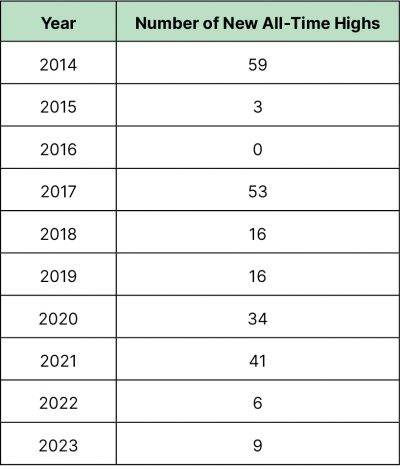The New Highs: Milestones or Warning Signs?
The first quarter of 2024 saw the US S&P 500 gain 10%, its best start to the year since 2019. Any weakness in the market was bought leading the index to a new high. All in all, there have been 22 new all-time closing highs for the S&P 500 in the first quarter of 2024. This means there has been a new all-time closing high on average every 4 days. While this average looks a bit too much as its measured over just a quarter, let’s look at some of the data (of the new all-time closing highs) in India over the last 10 years. If you had to take a guess about the number of all-time closing highs the Indian stock market index -Nifty 50 has made over the last 10 years, what would that number look like…
The answer is 237 all-time new closing highs (ATH)…This means on an average 23.7 ATH every year, which translates to an ATH every 15.4 days.

What Do New All Time Highs Really Mean?
The phenomenon of the stock market hitting new all-time highs (ATHs) can be a bellwether for economic optimism. It typically indicates that investors are confident about future corporate earnings and the overall health of the economy. A streak of ATHs often reflects a period of sustained growth, during which time companies are performing well, consumers are spending, and the economic indicators are positive.
However, new highs are also snapshots — they capture market sentiment at a specific moment and do not necessarily predict future performance. The S&P 500 reaching new highs is an aggregate reflection of its constituent companies, and similar is the case with India’s Nifty 50. These milestones are often celebrated in the media and can contribute to investor euphoria, yet they are not the sole barometer of market health.
How Useful Are New Highs to Investors?
For investors, new highs can serve as both an affirmation and a caution. On one hand, they validate the performance of the market and can signal the strength of their current investments. On the other hand, new highs should be approached with analytical prudence. They should not prompt impulsive investment decisions, as new highs do not guarantee continued upward trajectories.
An overemphasis on ATHs can lead to what’s known as the “peak-end rule,” a cognitive bias where investors judge an experience almost entirely by its peak (i.e., the new high) and how it ends, rather than the sequence of events leading up to and following the peak. This can distort investment perceptions and lead to over-optimism about continued market performance.
Behavioural Impact of New Highs
New highs can also lead to a change in investor behaviour, a phenomenon underpinned by behavioural finance. The ‘herding effect’ is one such behaviour, where investors follow the crowd into buying stocks, which can inflate prices and drive the market to new highs. Conversely, new highs can trigger anxiety for some investors who fear a subsequent market drop, leading to a sell-off that may not be warranted by fundamentals.
The Relevance of Market Breadth
The breadth of the market, which refers to the number of stocks participating in the rally to new highs, is an often overlooked but critical aspect. A market reaching new highs led by only a few large-cap stocks may indicate weakness in the broader market. In contrast, new highs supported by a wide range of stocks across different sectors suggest a healthier, more robust market rally.
New Highs and the Economic Cycle
Understanding where the market stands in the economic cycle can also give context to the significance of new highs. Typically, new highs reached during the early to middle stages of an economic recovery can be indicative of future growth potential. However, new highs that occur late in an economic cycle may signal caution, as they could precede a cyclical downturn.
Valuation Metrics and New Highs
Investors should also be wary of valuation metrics during times of new highs. Metrics such as price-to-earnings ratios tend to be higher when the market is peaking. If these ratios are significantly above historical averages, it could suggest that stocks are overvalued, implying that new highs are being driven by excess liquidity or speculation rather than genuine growth.
The Role of International Markets
The influence of international markets is another nuanced factor. Global liquidity and cross-border capital flows can have a significant impact on domestic markets, often driving them to new highs irrespective of domestic economic conditions. Investors should be mindful of global economic trends and their potential impact on local markets.
Actionable Insights
When confronted with data about new market highs, here’s what you should consider:
Review and Rebalance: Use new highs as a checkpoint to review and potentially rebalance your portfolio. If the increase in stock prices has pushed your asset allocation out of sync with your risk tolerance, it may be time to sell some equities and buy fixed-income securities, or vice versa.
Long-Term Perspective: Remember that investing is a marathon, not a sprint. New highs should not dramatically change long-term investment strategies. Instead, they should reaffirm the importance of staying the course and sticking to a well-thought-out financial plan.
Risk Assessment: Consider the possibility of a reversion. Markets that reach new highs can also be more susceptible to pullbacks, as valuations stretch, and investors’ risk appetites become more conservative. This is an opportune time to assess the risk levels within your portfolio and ensure they align with your investment horizon and financial goals. Plan for the worst case including a recession. This involves being prepared by reassessing your liquidity needs and securing cash reserves.
Economic Context: Contextualize new highs within the broader economic landscape. Is the market’s rise supported by strong fundamentals, or is it being driven by speculative trading or liquidity influx? Understanding the underlying factors can provide guidance on how to navigate the current market.
Emotional Discipline: Do not let emotions steer your investment decisions. The thrill of new highs can lead to exuberance, while the fear of missing out can drive investors to take on undue risk. It’s crucial to remain disciplined and not deviate from your investment plan based on short-term market movements.
Investment Strategy in Light of New Highs
A deeper insight is to understand that new highs are not a destination but a point along the investment journey. They should not fundamentally alter a well-diversified investment strategy. Instead, they offer a moment for investors to reassess their portfolios in light of their long-term financial objectives.
In essence, while new highs can be a sign of a thriving market, they should be considered with discernment. Investors are best served by focusing on their individual financial goals and the composition of their portfolios rather than being swayed by the headlines. By doing so, they can use the information about new highs as a tool for thoughtful investment decision-making rather than as a directive for action.





 and then tap on
and then tap on 

0 Comments